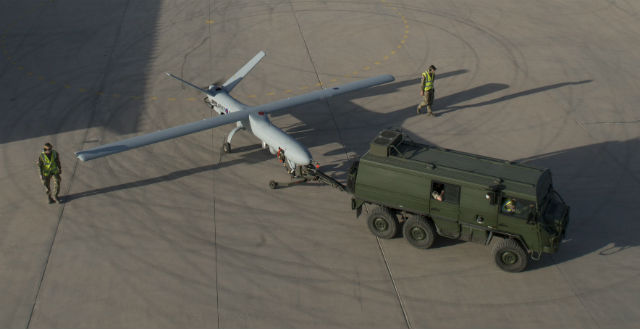The British Army is to assume responsibility for training on its Thales WK450 Watchkeeper unmanned air vehicle as of October, as it heads towards full operational capability (FOC) with the system.
The programme will follow the same format as the training conducted by Thales, including classroom and theoretical training at a facility in Larkhill, Wiltshire and live training at the army’s Boscombe Down facility, also in Wiltshire.
Throughout the training process with Thales, selected army personnel have been trained both to operate the tactical UAV and to become instructors to pass on training to future operators.
The first student course will begin in October, as the system heads towards the next operational phase. “We have two years to get from initial operational capability to fully operational capability,” Lt Col Craig Palmer, SQI unmanned air systems, British Army, says.
To achieve FOC a range of capabilities will be added to the system – namely de-icing, the ability to land on rough landing strips and mapping – and funding has been allocated for this development cycle.
“We’ve taken a lot of baby steps and now we’re striding forward,” Palmer notes. “At the current time the future programme contains nothing… it could contain anything. While still in its early days, we have a funded programme through to 2042.”
Palmer also notes that the ability to land on rough landing strips is particularly important, and that “austere bases” will be operational ground in the future: “The places in the world that we want to operate don’t have airfields,” he says. “There are lots of places in North Africa that don’t have airfields… [so] in two years’ time it will operate from rough strips that we create.”

Crown Copyright
Watchkeeper recorded operational success in a deployment to Afghanistan in August and September, which involved the type providing synthetic aperture radar and ground moving target indication surveillance under the US Marine Corps’ operations in-theatre, as British troops withdrew from theatre.
The SAR/GMTI radar was the “game changer” for Watchkeeper, Palmer adds, as it is a capability the previously operated and leased Elbit Systems Hermes 450 UAV – which is also the base design for the WK450 – did not have. The level of information provided by one WK450 would have taken three Hermes 450s, Palmer adds.
“The effects it had in Afghanistan were particularly precise,” he says.
The civil potential of Watchkeeper has been touted by both Thales and Palmer, with the latter noting that the aircraft routinely flies over urban areas, and this will be the nature of army operations in the future – not necessarily flying within segregated military zones.
Source: FlightGlobal.com



















